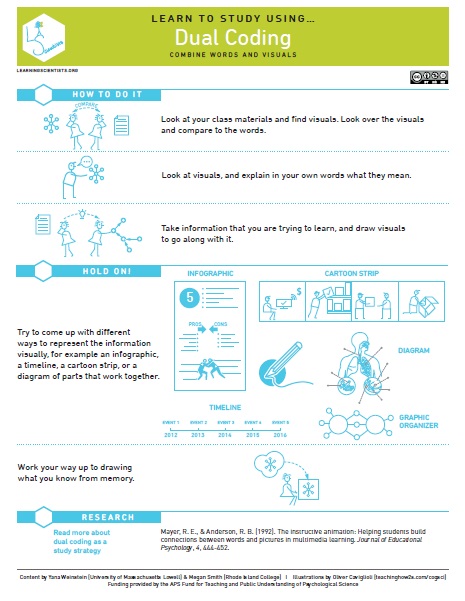This is the fourth post in a series looking at the most effective ways to revise, based on the work of The Learning Scientists. The Learning Scientists are cognitive psychologists who want to make scientific research on learning more accessible to students and teachers. Their aim is to motivate students to study and increase the use of effective study and teaching strategies that are backed by research. I’ve met Yana Weinstein PhD at an education conference in Southampton last week – she’s the real deal!
Read all the revision posts here.
Dual Coding: what is it?
Dual coding is when you use a combination of pictures/visuals and words to help you learn material.
Dual Coding: why?
By transferring the material from a visual form into words, or from words into visuals, you are strengthening the connections in your brain around the material itself. You are also giving yourself multiple formats to remember things in – the words might act as a memory hook for the visuals, or you might remember the visuals and that will trigger the memory of the words.
Dual coding: how do I do it?
If you have a textbook, look for the visuals and see what the connection is between those and the words. What does the visual tell you that the words don’t? What do the words clarify that isn’t clear in the visual? Asking these questions helps secure your knowledge of all aspects of the topic.
When you are revising, draw visuals to go along with each section of your written notes. This could be a timeline, a diagram, a flow-chart, a mind-map, an illustration, an infographic or whatever you want!
If you have diagrams, illustrations or other visuals to work from, write down in your own words what the visual is telling you. Processing the information from one code (visual) to another (words) helps you to recall it later.
Dual coding: next steps
When you are first starting out, you will have your notes, textbook or resources in front of you. As you get better, try to dual code without the material in front of you – drawing a visual representation of the material from memory, or writing a description or explanation of the visual in your own words without looking at it. This combines dual coding with retrieval practice to help secure your revision.

Hello! We’re thrilled that you decided to use the materials to help teach students about revision. There’s just one problem. We registered the posters under a creative commons license, meaning that people can use them for free so long as they are not for commercial use (yours are clearly not) and they are presented in full. The reason for this is that we do not want anyone editing or cutting portions off so that the science stays intact (and the acknowledgments stay intact, too). The graphics should not be used unless they are a part of the full poster. Please include the full posters in these materials, and remove any graphics aside from within the posters. Thanks! Megan (and Yana)
LikeLike
No problem! Leave it with me and I’ll sort it. Sorry for any problems with this.
LikeLike
All sorted, credited and posters posted in full. Thanks for all the work you’ve done in putting the materials together – they’re so useful.
LikeLike
Great!! Thanks.
LikeLike
Pingback: How to do revision right | The Headteacher's Blog